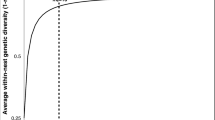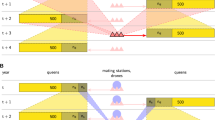Abstract
Two-way selection for quantities of stored pollen resulted in the production of high and low pollen hoarding strains of honey bees (Apis mellifera L.). Strains differed in areas of stored pollen after a single generation of selection and, by the third generation, the high strain colonies stored an average 6 times more pollen than low strain colonies. Colony-level organizational components that potentially affect pollen stores were identified that varied genetically within and between these strains. Changes occurred in several of these components, in addition to changes in the selected trait. High strain colonies had a significantly higher proportion of foragers returning with loads of pollen, however, high and low strain colonies had equal total numbers of foragers Colony rates of intake of pollen and nectar were not independent. Selection resulted in an increase in the number of pollen collectors and a decrease in the number of nectar collectors in high strain colonies, while the reciprocal relationship occurred in the low strain. High and low strain colonies also demonstrated different diurnal foraging patterns as measured by the changing proportions of returning pollen foragers. High strain colonies of generation 3 contained significantly less brood than did low strain colonies, a consequence of a constraint on colony growth resulting from a fixed nest volume and large quantities of stored pollen. These components represent selectable colony-level traits on which natural selection can act and shape the social organization of honey bee colonies
Similar content being viewed by others
References
Calderone NW, Page RE (1988) Genotypic variability in age polyethism and task specialisation in the honey bee, Apis mellifera (Hymenoptera: Apidae). Behav Ecol Sociobiol 22:17–25
Calderone NW, Page RE (1991) The evolutionary genetics of division of labor in colonies of the honey bee (Apis mellifera). Am Nat 138:69–92
Calderone NW, Page RE (1992) Effects of interactions among genetically diverse nestmates on task specialization by foraging honey bees (Apis mellifera). Behav Ecol Sociobiol 30:219–226
Crozier RH, Page RE (1985) On being the right size: male contributions and multiple mating in social Hymenoptera. Behav Ecol Sociobiol 18:105–115
Fewell JH, Page RE (1993) Genotypic variation in foraging responses to environmental stimuli by honey bees, Apis mellifera. Experientia 49:1106–1112
Fewell JH, Winston M L (1992) Colony state and regulation of pollen foraging in the honey bee, Apis mellifera L. Behav Ecol Sociobiol 30:387–393
Gary NE, Lorenzen K (1976) A method for collecting the honeysac contents from honeybees. J Apic Res 15:73–79
Gary NE, Lorenzen K (1990) Vacuum devices for capturing and partitioning commingled subpopulations of honey bees (Hymenoptera: Apidae). Ann Entomol Soc Am 83:1152–1154
Guzmán-Novoa E, Gary NE (1993) Genotypic variability of components of foraging behavior in honey bees (Hymenoptera: Apidae). J Econ Entomol 86:715–721
Guzmán-Novoa E, Page RE, Gary NE Gary (1994) Behavioral and life history components of division of labor in honey (Apis mellifera L.). Behav Ecol Sociobiol 34:409–417
Hellmich RL, Kulincevic JM, Rothenbuhler WC (1985) Selection for high and low pollen-hoarding honey bees. J Hered 76:155–158
Huang Z-Y, Robinson GE (1992) Honeybee colony integration: worker-worker interactions mediate hormonally regulated plasticity in division of labor. Proc Natl Acad Sci USA 89:11726–11729
Kauffeld N (1975) Overwintering of colonies of honey bees with restricted and unrestricted broodrearing in Louisiana. Am Bee J 115:480, 481, 490
Kolmes SA, Winston ML, Fergusson LA (1989) The division of labor among worker honey bees (Hymenoptera:Apidae): the effects of multiple patrilines. J Kan Entomol Soc 62:80–95
Laidlaw HH (1977) Instrumental insemination of honey bee queens. Dadant, Hamilton
Laidlaw HH (1979) Contemporary queen rearing. Dadant, Hamilton
Nolan WJ (1925) The brood rearing cycle of the honey bee (USDA Bulletin 1349). United States Department of Agriculture, Washington
Oldroyd BP, Rinderer TE, Harbo JR, Buco M (1992) Effects of intracolonial genetic diversity on honey bee (Hymenoptera: Apidae) colony performance. Ann Entomol Soc Am 85:335–343
Page RE (1986) Sperm utilization in social insects. Annu Rev Entomol 31:297–320
Page RE, Mitchell SD (1991) Self organization and adaptation in insect societies. In: Fine A, Forbes M, Wessels L (eds) PSA, Vol 2. Philosophy of Science Association, East Lansing, Michigan, pp 289–298
Page RE, Robinson GE (1991) The genetics of division of labour in honey bee colonies. Adv Insect Physiol 23:118–169
Page RE, Fondrk MK, Robinson GE (1993) Selectable components of sex allocation in colonies of the honeybee. Behav Ecol 4:239–245
Page RE, Robinson GE, Britton DS, Fondrk MK (1992) Genotypic variability for rates of behavioral development in worker honeybees (Apis mellifera L.). Behav Ecol 3:173–180
Robinson GE, Page RE (1989) Genetic basis for division of labor in an insect society. In Breed MD, Page RE (eds) The genetics of social evolution, Westview, Boulder, pp 61–80
Seeley TD (1989) The honey bee colony as a superorganism. Am Sci 77:546–553
Seeley TD, Morse RA (1976) The nest of the honey bee (Apis mellifera). Ins Soc 23:495–512
Sherman PW, Seeley TD, Reeve HK (1988) Parasites, pathogens, and polyandry in the social Hymenoptera. Am Nat 131: 602–610
Sokal RR, Rohlf FJ (1981) Biometry. Freeman, New York
Winston ML (1987) The biology of the honey bee. Cambridge
Woyke J (1986) Sex determination. In: Rinderer TE (ed) Bee genetics and breeding. Academic Press, New York, pp 91–119
Author information
Authors and Affiliations
Additional information
Communicated by R.F.A. Moritz
Rights and permissions
About this article
Cite this article
Page, R.E., Fondrk, M.K. The effects of colony-level selection on the social organization of honey bee (Apis mellifera L.) colonies: colony-level components of pollen hoarding. Behav Ecol Sociobiol 36, 135–144 (1995). https://doi.org/10.1007/BF00170718
Received:
Accepted:
Issue Date:
DOI: https://doi.org/10.1007/BF00170718




